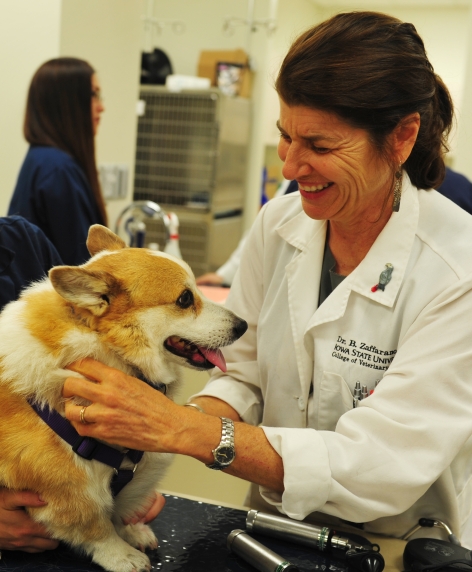
Dr. Bianca Zaffarano, pictured above, is encouraging pet owners to pay close attention to changes exhibited by older animals as they age. Larger photo. Photo courtesy of ISU College of Veterinary Medicine.
AMES, Iowa – Just like the humans for whom they provide steadfast companionship and loyalty, pets often require extra medical consideration as they enter their golden years, a small animal veterinarian at Iowa State University said this week.
In recognition of September as “Senior Pet Health Month,” Dr. Bianca Zaffarano, a clinician in the ISU Department of Veterinary Clinical Sciences, is reminding pet owners to pay close attention to changes their animals exhibit as they age.
Zaffarano said pet owners sometimes show a tendency to dismiss seemingly minor changes as inevitable signs of getting older, but those symptoms may have roots in a more serious condition.
“Animals age more rapidly than we do, obviously,” she said. “But sometimes the symptoms we just chalk up to aging are actually the result of something more serious going on.”
Zaffarano said older animals can suffer from significant health conditions while displaying only subtle differences in behavior – if they display any differences at all.
“The animals can act like they’re in great shape, even when something is physically wrong with them,” she said. “That’s particularly true with cats. They’re an amazingly stoic species.”
She said common conditions found in elderly pets include arthritis, obesity, diabetes, hyperthyroidism, cataracts and cancerous lumps. Some of those conditions, such as arthritis, are easily treatable, but animals sometimes must endure the condition needlessly if they don’t receive a regular physical examination by a veterinarian.
Zaffarano encouraged pet owners to pay close attention to any changes in an animal’s activity levels, appetite, water consumption or visual acumen. Perhaps most importantly, she recommended that owners of senior pets have them examined by a veterinarian at least every six months.
As a general rule, Dr. Zaffarano said pet owners should begin stepping up their vigilance when an animal reaches 7 years of age. However, different species – and even different breeds within a species – age at different speeds, she said.
For instance, larger dog breeds, such as Great Danes, age more rapidly than smaller breeds. Zaffarano said large breeds are considered elderly around age 5, while the 7-year rule is about right for small dogs.
She said pets don’t generally require drastic changes in diet as they age unless a health condition limits what an animal can eat. However, older pets are generally less active and may require smaller portions, she cautioned.
Zaffarano said exercise is just as important for animals as it is for humans and urged pet owners to make sure aging animals get an appropriate amount of physical activity. As with food portions, she said older animals may need less exercise than they did when they were younger.
“Exercise needs to be done according to the cues of the animal,” she said. “If they’re unable to tolerate it, you may have to shorten your walks.”